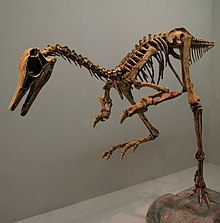| Patagonykus | |
|---|---|

| |
| Reconstructed skeleton | |
| Scientific classification | |
| Domain: | Eukaryota |
| Kingdom: | Animalia |
| Phylum: | Chordata |
| Clade: | Dinosauria |
| Clade: | Saurischia |
| Clade: | Theropoda |
| Clade: | †Patagonykinae |
| Genus: | †Patagonykus Novas, 1996 |
| Species: | †P. puertai
|
| Binomial name | |
| †Patagonykus puertai Novas, 1996
| |

Patagonykus (meaning "Patagonian claw") is a genus of theropod dinosaur from the Upper Cretaceous of Argentina. This alvarezsauroid was discovered in exposures of the Portezuelo Formation (Turonian-Coniacian) of the Rio Neuquén Subgroup in the Neuquén Basin, Neuquen Province of Patagonia, Argentina. The holotype consists of an incomplete but well-preserved skeleton, lacking a skull, but including many vertebrae, the coracoids, a partial forelimb, pelvic girdle, and hindlimbs. Patagonykus has been classed with the Alvarezsauridae, a family which includes such taxa as the Mongolian Mononykus and the Argentinian Alvarezsaurus. In 2010 Gregory S. Paul estimated its length at 1 meter (3.3 ft) and its weight at 3.5 kg (7.7 lbs).[1]
- ^ Paul, Gregory S. (2010). The Princeton Field Guide to Dinosaurs. New Jersey: Princeton University Press. p. 127.